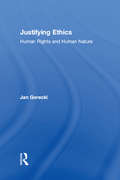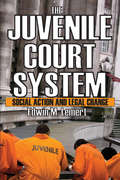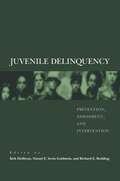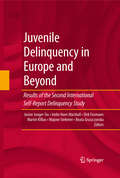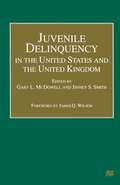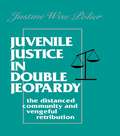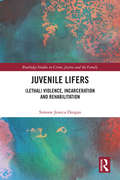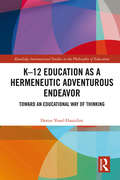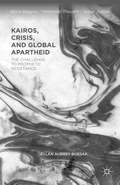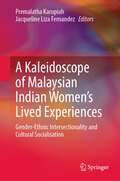- Table View
- List View
Justifying Ethics: Human Rights and Human Nature
by Jan Gorecki"Human rights include individual rights against government oppression, such as the right to freedom of thought, religion, speech, assembly, and to a fair system of criminal justice. But even in this basic political sense, ""human rights"" means different things in different historical and cultural contexts and advocacy of such rights has frequently been viewed as subjective. Justifying Ethics offers a thorough critique of the most common attempts to formulate objective standards through appeals to human nature, religion, and reason. Gorecki opens his inquiry by considering the role of norm-making concepts in the history of ethical thought: how standards of rights were claimed to conform to human nature and reason or have been stipulated by an external authoritative source such as God or social contracts. He then shows how such justifications may be discounted on analytical or practical grounds using such examples as divine will, Kantian reason, and the truth value of moral judgments. With respect to empirically grounded appeals to human nature, Gorecki argues against the notion that the innate plasticity of human behavior and potential for social diversity is sufficient grounds for human rights activity without objective justification. The search for justification remains essential in enhancing the persuasiveness of ethical action that aims at the moral ""contagion"" of the people by the human rights experience and the transition from moral acceptance to legal implementation.Broad in intellectual scope, Justifying Ethics draws upon moral and political philosophy, social policy, psychology, history, jurisprudence, and international law to clarify the prerequisites for the success of human rights activity. The book will be of special interest to political theorists, philosophers, sociologists, and human rights activists."
Justifying Interventions in Africa: (De)Stabilizing Sovereignty in Liberia, Burundi and the Congo
by N. WilénThis new paperback edition of Justifying Interventions in Africa includes a new preface written by Professor Annika Björkdahl from Lund University. Analysing the UN interventions in Liberia, Burundi and the Congo, Wilén poses the question of how one can stabilize a state through external intervention without destabilizing sovereignty. She critically examines the justifications for international and regional interventions through a social constructivist framework.
Justiz - die stille Gewalt: Teilnehmende Beobachtung und entscheidungssoziologische Analyse
by Rüdiger LautmannDas Buch behandelt ein zentrales Thema der Rechtssoziologie: die Justiz. Die dritte Gewalt im Staate arbeitet ja zurückgezogen und still; sie war bislang für Sozialwissenschaftler nur schwer zugänglich. Der Verfasser konnte die Entscheidungsabläufe ausführlich beobachten. So ist sein Bericht die erste umfassende empirische Analyse der richterlichen Urteilsfindung. Die Entscheidungsstrukturen einer wichtigen politischen Institution werden hier bloßgelegt. (Umschlagtext zur Erstausgabe 1972)
Juve!: 100 Years of an Italian Football Dynasty
by Herbie SykesThe definitive history of the iconic football club: the glory, the scandal, the stars and its enduring influence on Italian life.Juventus utterly dominates the Italian game. Home to some of the biggest names in sport, it has won title after title, trophy after trophy. However, parallel to the success and myth, there’s a murkier reality. For one hundred years the club and its billionaire owners, the Agnelli family, have been synonymous with match-fixing, doping, political chicanery and more. While La Vecchia Signora remains Italy’s best-supported team, it’s also its most despised.Juve! charts the story of Italy’s great sporting dynasty, chronicling the triumphs and tragedies of the Agnellis, and of the icons – Boniperti, Del Piero, Ronaldo – who have been their sporting emissaries for almost a century. The pride of Italy or its dark heart? Footballing colossus or vanity project? With this unique institution, as with so much about life in Italy, things are seldom black and white…
The Juvenile Court System: Social Action and Legal Change
by Edwin LemertThis volume is based on a detailed analysis of change in the law and in the administration of justice affecting juvenile off enders in California in the fifties and sixties. It addresses how procedural law develops on a long-term basis and under what conditions. It also examines the processes by which revolutionary changes occur in law and the extent to which social change can be directed or controlled by legislation.Social action to revise California's juvenile court law, which had remained little changed since 1915, began in 1958. Subsequently a small group of legal reformers who perceived anomalies in the law and in the underlying philosophy of the court overcame substantial resistance to effect revolutionary revisions of the law. Lemert examines their experience to determine how changes of such magnitude could take place after decades of gradual adaptations in the juvenile courts. His study also looks into the consequences of this change on the court and related agencies of law enforcement.The author sets forth a socio-legal theory of change-a conception of paradigms, normal evolution, and revolution in law. He applies this theory to data, with special attention to the resistance to legal change and the processes by which it gives way to the adaptive process of normal law. Lemert discusses the substantive aspects of juvenile law as it relates to human affect and meaning, touching on the existential elements of justice. Professionals dealing with juveniles, legal scholars, sociologists, and political scientists will find this book, with its emphasis on how to achieve more equitable administration of juvenile justice, has much to contribute to our understanding of the dynamics of social change.
The Juvenile Court System: Social Action and Legal Change
by Edwin LemertThis volume is based on a detailed analysis of change in the law and in the administration of justice affecting juvenile off enders in California in the fifties and sixties. It addresses how procedural law develops on a long-term basis and under what conditions. It also examines the processes by which revolutionary changes occur in law and the extent to which social change can be directed or controlled by legislation.Social action to revise California's juvenile court law, which had remained little changed since 1915, began in 1958. Subsequently a small group of legal reformers who perceived anomalies in the law and in the underlying philosophy of the court overcame substantial resistance to effect revolutionary revisions of the law. Lemert examines their experience to determine how changes of such magnitude could take place after decades of gradual adaptations in the juvenile courts. His study also looks into the consequences of this change on the court and related agencies of law enforcement.The author sets forth a socio-legal theory of change-a conception of paradigms, normal evolution, and revolution in law. He applies this theory to data, with special attention to the resistance to legal change and the processes by which it gives way to the adaptive process of normal law. Lemert discusses the substantive aspects of juvenile law as it relates to human affect and meaning, touching on the existential elements of justice. Professionals dealing with juveniles, legal scholars, sociologists, and political scientists will find this book, with its emphasis on how to achieve more equitable administration of juvenile justice, has much to contribute to our understanding of the dynamics of social change.
Juvenile Delinquency: Prevention, Assessment, and Intervention
by Kirk Heilbrun Naomi E. Sevin Goldstein Richard E. ReddingJuvenile offending and anti-social behavior are enormous societal concerns. This broad-reaching volume summarizes the current evidence on prevention, diversion, causes, and rates of delinquency, as well as assessment of risk and intervention needs. A distinguished cast of contributors from law, psychology, and psychiatry describe what we know about interventions in school, community, and residential contexts, focusing particularly on interventions that are risk reducing and cost effective. Equally important, each chapter comments on what is not well supported through research, distinguishing aspects of current practice that are likely to be effective from those that are not and mapping new directions for research, policy, and practice. Finally, the volume provides a description of a model curriculum for training legal and mental health professionals on conducting relevant assessments of adolescents for the courts. Effectively bridging research and practice, this will be an important resource for legal and mental health professionals involved in the juvenile justice system, policy makers seeking humane but effective interventions in the context of society's need for safety, and those involved in teaching about and training in juvenile delinquency.
Juvenile Delinquency in Europe and Beyond: Results of the Second International Self-Report Delinquency Study
by Josine Junger-Tas Martin Killias Ineke Haen Marshall Beata Gruszczynska Majone Steketee Dirk EnzmannJuvenile Delinquency in Europe and Beyond: Results of the Second International Self-Report Delinquency Study presents the status of juvenile crime and delinquency and its backgrounds in many of the European Union member states as well as in the United States, Canada, Venezuela and Surinam. The book includes information on key issues in juvenile delinquency such as victimization of young people, alcohol and drug use and its relation to juvenile crime, involvement in youth gangs, immigration, family and school and neighborhood situations. It provides insight into different views on what can be considered juvenile crime; what acts are subsumed in its definition and when we can speak about structural delinquent behavior. These insights are based on self-reported information systematically and simultaneously collected from about 70,000 12-15 year old youths in 28 countries. Until recently, the self-report methodology has not been applied on such a large scale in an international context. The results of this survey provide new and unexpected data about those young people who structurally commit criminal acts, as well as on the frequency of the behavior and the conditions that have an impact on offending. The wealth of descriptions and insights in delinquency of all these countries will be of great interest to scholars, students and practitioners because of the special character of the publication; it is a book of reference to everyone interested in the backgrounds of juvenile delinquency.
Juvenile Delinquency in the United States and the United Kingdom
by Gary L. McDowell Jinney SmithThis volume about juvenile delinquency in the United States and United Kingdom includes a foreword, nine chapters organized in three parts, and an afterword. Chapters 1 and 2 in Part I describe juvenile delinquency in both countries and the urgency of the current crisis. Chapters 3 to 6 in Part II deal with the two nations' juvenile justice systems, focusing on structural and ideological obstacles preventing reform. Presented in the final chapters in Part III are suggestions for reform in school, and juvenile justice setting that recognize the importance of character in causing delinquency.
Juvenile Justice in Britain and the United States: The Balance of Needs and Rights
by Phyllida ParsloeThis study, first published in 1978, compares the ways in which the systems in England, Scotland and the United States balance the necessity of meeting children‘s needs against the protection of their rights. Three approaches to juvenile justice are identified; the criminal justice, the welfare, and the community approach. This book will be of interest to students of sociology, criminology and social work.
Juvenile Justice in Britain and the United States: The Balance of Needs and Rights (Routledge Revivals Ser.)
by Phyllida ParsloeThis study, first published in 1978, compares the ways in which the systems in England, Scotland and the United States balance the necessity of meeting children‘s needs against the protection of their rights. Three approaches to juvenile justice are identified; the criminal justice, the welfare, and the community approach. This book will be of interest to students of sociology, criminology and social work.
Juvenile Justice in Double Jeopardy: The Distanced Community and Vengeful Retribution
by The Honorable PolierThroughout her entire career, Judge Polier continually fought for the rights and needs of the poor. In this volume she describes the granting and denial of justice toward the poor -- particluarly poor children -- she observed during her tenure as a Family Court Judge in New York City. The book discusses the current state of the justice system and the outlook for the future. This volume helps readers understand how broadly shared the responsibility for the neglect of today's youth is and how society must reshape its attitudes and realign its priorities to help the thousands of children who are dependent upon the public for care and support. The book identifies how the courts have been weakened by their loss of direct contact with delinquent and neglected children and the "need for humanity and respect in dealing with difficult human problems." (from the introduction). From her personal experiences and observations, Judge Polier describes the granting and denial of justice she observed while she consistently emphasizes the need for direct contact with delinquent and neglected children. For students, professional, and researchers in sociology, criminal justice, and any social science discipline dealing with children and children's problems, Polier's book provides a behind-the-scenes look at one of the major problems facing society today.
Juvenile Justice in Double Jeopardy: The Distanced Community and Vengeful Retribution
by The Honorable PolierThroughout her entire career, Judge Polier continually fought for the rights and needs of the poor. In this volume she describes the granting and denial of justice toward the poor -- particluarly poor children -- she observed during her tenure as a Family Court Judge in New York City. The book discusses the current state of the justice system and the outlook for the future. This volume helps readers understand how broadly shared the responsibility for the neglect of today's youth is and how society must reshape its attitudes and realign its priorities to help the thousands of children who are dependent upon the public for care and support. The book identifies how the courts have been weakened by their loss of direct contact with delinquent and neglected children and the "need for humanity and respect in dealing with difficult human problems." (from the introduction). From her personal experiences and observations, Judge Polier describes the granting and denial of justice she observed while she consistently emphasizes the need for direct contact with delinquent and neglected children. For students, professional, and researchers in sociology, criminal justice, and any social science discipline dealing with children and children's problems, Polier's book provides a behind-the-scenes look at one of the major problems facing society today.
Juvenile Lifers: (Lethal) Violence, Incarceration and Rehabilitation (Routledge Studies in Crime, Justice and the Family)
by Simone DeeganThis book is the first Australian study, based on extensive fieldwork, of the personal backgrounds and processes by which juveniles get drawn into risky and violent situations that culminate in murder. Drawing on interviews with every juvenile under sanction of life imprisonment in the State of South Australia (2015–2019), it investigates links in the chain of events that led to the lethal violence that probably would have been broken had there been appropriate intervention. Specifically, the book asks whether the existing criminal justice frame is the appropriate way to deal with children who commit grave acts. The extent to which prison facilitates and/or inhibits the mental, emotional, and social development of juvenile ‘lifers’ is a critical issue. Most – if not all – will be released at some point, with key issues of risk (public protection) and rehabilitation (probability of desistance) coming sharply to the fore. In addition, this book is also the first to capture how significant others including mothers, fathers, grandparents, and siblings are affected when children kill and the level of commitment these relatives have towards supporting the prisoner in his or her quest to build a positive future. Written in a clear and direct style, this book will appeal to students and scholars of criminology, sociology, andpenology; practitioners working in social policy; and all those interested in the lives and backgrounds of juvenile offenders.
Juvenile Lifers: (Lethal) Violence, Incarceration and Rehabilitation (Routledge Studies in Crime, Justice and the Family)
by Simone DeeganThis book is the first Australian study, based on extensive fieldwork, of the personal backgrounds and processes by which juveniles get drawn into risky and violent situations that culminate in murder. Drawing on interviews with every juvenile under sanction of life imprisonment in the State of South Australia (2015–2019), it investigates links in the chain of events that led to the lethal violence that probably would have been broken had there been appropriate intervention. Specifically, the book asks whether the existing criminal justice frame is the appropriate way to deal with children who commit grave acts. The extent to which prison facilitates and/or inhibits the mental, emotional, and social development of juvenile ‘lifers’ is a critical issue. Most – if not all – will be released at some point, with key issues of risk (public protection) and rehabilitation (probability of desistance) coming sharply to the fore. In addition, this book is also the first to capture how significant others including mothers, fathers, grandparents, and siblings are affected when children kill and the level of commitment these relatives have towards supporting the prisoner in his or her quest to build a positive future. Written in a clear and direct style, this book will appeal to students and scholars of criminology, sociology, andpenology; practitioners working in social policy; and all those interested in the lives and backgrounds of juvenile offenders.
The Juvenile Offender: Theory, Research and Applications (International Series in Outreach Scholarship #5)
by Robert D. HogeThis book provides a discussion ofadvances in our understanding of the juvenile offender. These derive from psychological and criminological theoryand researchonthe phenomenonofyouth crime and from efforts on the part of social science researchers and practitioners to develop and evaluate new approaches to prevention and treatment. The theoretical and empirical advances relate, first, to analyses of the nature and extent ofyouth crime. This is reflected, for example, in various descriptive and classification systems developed for characterizingjuvenile offenders. Significant advances are also being made in understanding the risk factors associated with youthful criminal activity, as well as the processes linking the risk factors with antisocial behaviors. This understanding is based on theory and research relatingto the correlates andcauses ofdelinquency. The advances in our understanding of the nature, correlates, and causes of juvenile crime are accompanied by progress in analyzing the treatment ofyouth in juvenile justice systems and in developing and evaluating alternative approaches to treatment. These efforts include research on decision-making within juvenile justice systems and the development of screening and assessment tools. This also includes efforts to develop and evaluate effective prevention and treatment programs for use with youths involved in criminal activity and those at risk for this activity.
K–12 Education as a Hermeneutic Adventurous Endeavor: Toward an Educational Way of Thinking (Routledge International Studies in the Philosophy of Education #17)
by Doron Yosef-HassidimConsidering the role of compulsory mass education and schooling in a democratic society, this book introduces an alternative vision for K-12 education as an "adventurous endeavour." Grounded in a strong theoretical framework, Yosef-Hassidim reveals the negative impact of instrumentalization of schools: when education is considered a social and political instrument, it serves dominant social forces’ interests rather than students’ or humanity as a whole. Offering conceptual and pragmatic frameworks to limit political influence on schooling, the author proposes a new hermeneutical structure that restores education’s agency and separates it from external social forces, and provides the foundation for regarding K-12 education as a sovereign social sphere in its own right.
K–12 Education as a Hermeneutic Adventurous Endeavor: Toward an Educational Way of Thinking (Routledge International Studies in the Philosophy of Education #17)
by Doron Yosef-HassidimConsidering the role of compulsory mass education and schooling in a democratic society, this book introduces an alternative vision for K-12 education as an "adventurous endeavour." Grounded in a strong theoretical framework, Yosef-Hassidim reveals the negative impact of instrumentalization of schools: when education is considered a social and political instrument, it serves dominant social forces’ interests rather than students’ or humanity as a whole. Offering conceptual and pragmatic frameworks to limit political influence on schooling, the author proposes a new hermeneutical structure that restores education’s agency and separates it from external social forces, and provides the foundation for regarding K-12 education as a sovereign social sphere in its own right.
Kairos, Crisis, and Global Apartheid: The Challenge to Prophetic Resistance (Black Religion/Womanist Thought/Social Justice)
by Allan Aubrey BoesakIn 1985, the Kairos Document emerged out of the anti-apartheid struggle as a devastating critique of apartheid and a challenge to the church in that society. This book is a call to discern new moments of crisis, discernment and kairos, and respond with prophetic resistance to global injustice.
Kaizen: The Japanese Secret to Lasting Change—Small Steps to Big Goals
by Sarah HarveyThe magic of kaizen—the Japanese method of taking small steps to accomplish huge goals—is now here for everyone in this gorgeously photographed and illustrated guide
KAIZEN-21: The Philosophy of Continuous Improvement and Operational Innovation in the New Global Environment (Emerald Points)
by Manuel F. Suárez-BarrazaSince Masaki Imai connected the term KAIZEN with the world management arena in 1986, this approach has been used as a strategy for company development that is propelled by the participation and motivation of its employees. Centering the human being as the guiding axis of change and innovation, KAIZEN-21 establishes a practical and theoretical guide for organizations to easily implement this ancestral philosophy within their operational processes in the midst of the chaotic and complicated global environment of the 21st century. Presenting an updated model of guiding principles, techniques, and tools, Manuel F. Suárez Barraza demonstrates how KAIZEN can be successfully applied in the context of pandemics, supply chain crises, and regional war. Beginning with the definition and origins of KAIZEN, chapters explore 5'S, standardization (Hiojunka), SDCA and PDCA cycles, as well as process innovation and kodawari-KAIZEN, or hitosukuri (management of people), closing with techniques for improving daily work, such as the the Kata of Improvement, and the author’s links with the Toyota Production System (TPS) and the Mayan work model (K’AAT-KAIZEN). If you are ready to energize your business team and revolutionize workplace practices, then KAIZEN-21 is your essential resource for prioritizing internal change and development despite all adversity.
KAIZEN-21: The Philosophy of Continuous Improvement and Operational Innovation in the New Global Environment (Emerald Points)
by Manuel F. Suárez-BarrazaSince Masaki Imai connected the term KAIZEN with the world management arena in 1986, this approach has been used as a strategy for company development that is propelled by the participation and motivation of its employees. Centering the human being as the guiding axis of change and innovation, KAIZEN-21 establishes a practical and theoretical guide for organizations to easily implement this ancestral philosophy within their operational processes in the midst of the chaotic and complicated global environment of the 21st century. Presenting an updated model of guiding principles, techniques, and tools, Manuel F. Suárez Barraza demonstrates how KAIZEN can be successfully applied in the context of pandemics, supply chain crises, and regional war. Beginning with the definition and origins of KAIZEN, chapters explore 5'S, standardization (Hiojunka), SDCA and PDCA cycles, as well as process innovation and kodawari-KAIZEN, or hitosukuri (management of people), closing with techniques for improving daily work, such as the the Kata of Improvement, and the author’s links with the Toyota Production System (TPS) and the Mayan work model (K’AAT-KAIZEN). If you are ready to energize your business team and revolutionize workplace practices, then KAIZEN-21 is your essential resource for prioritizing internal change and development despite all adversity.
Kakuma Refugee Camp: Humanitarian Urbanism in Kenya's Accidental City (Politics and Development in Contemporary Africa)
by Bram J. JansenKenya's Kakuma refugee camp is one of the world's largest, home to over 100,000 people drawn from across east and central Africa. Though notionally still a 'temporary' camp, it has become a permanent urban space in all but name with businesses, schools, a hospital and its own court system. Such places, Bram J. Jansen argues, should be recognised as 'accidental cities', a unique form of urbanization that has so far been overlooked by scholars.Based on extensive ethnographic fieldwork, Jansen's book explores the dynamics of everyday life in such accidental cities. The result is a holistic socio-economic picture, moving beyond the conventional view of such spaces as transitory and desolate to demonstrate how their inhabitants can develop a permanent society and a distinctive identity. Crucially, the book offers important insights into one of the greatest challenges facing humanitarian and international development workers: how we might develop more effective strategies for managing refugee camps in the global South and beyond.An original take on African urbanism, Kakuma Refugee Camp will appeal to practitioners and academics across the social sciences interested in social and economic issues increasingly at the heart of contemporary development.
Kakuma Refugee Camp: Humanitarian Urbanism in Kenya's Accidental City (Politics and Development in Contemporary Africa)
by Bram J. JansenKenya's Kakuma refugee camp is one of the world's largest, home to over 100,000 people drawn from across east and central Africa. Though notionally still a 'temporary' camp, it has become a permanent urban space in all but name with businesses, schools, a hospital and its own court system. Such places, Bram J. Jansen argues, should be recognised as 'accidental cities', a unique form of urbanization that has so far been overlooked by scholars.Based on extensive ethnographic fieldwork, Jansen's book explores the dynamics of everyday life in such accidental cities. The result is a holistic socio-economic picture, moving beyond the conventional view of such spaces as transitory and desolate to demonstrate how their inhabitants can develop a permanent society and a distinctive identity. Crucially, the book offers important insights into one of the greatest challenges facing humanitarian and international development workers: how we might develop more effective strategies for managing refugee camps in the global South and beyond.An original take on African urbanism, Kakuma Refugee Camp will appeal to practitioners and academics across the social sciences interested in social and economic issues increasingly at the heart of contemporary development.
A Kaleidoscope of Malaysian Indian Women’s Lived Experiences: Gender‐Ethnic Intersectionality and Cultural Socialisation
by Premalatha Karupiah Jacqueline Liza FernandezThis book presents a compilation of chapters relating to the socio-cultural experiences of Malaysian Indian women. It includes a historical background covering Indian women’s migration to Malaya, and explores the lived realities of contemporary Indian women who are members of this minority ethnic group in the country. The authors cover a wide range of issues such as gender inequality, poverty, the involvement of women in performing arts, work, inter‐personal relationships, and well-being and happiness, drawing on substantial empirical data through a gendered lens. This book addresses the gap in the intersectional gender studies literature on minority groups of women in Malaysia, while simultaneously highlighting the multiple forms of subordination minority women - particularly Indian women - experience in society, including those that arise from gender‐ethnic intersectionality. In examining the case of Indian women in Malaysia, it also speaks to and enriches existing literature on the lives of minority groups of women in the Global South more broadly This anthology is beneficial to researchers and students in the social sciences, particularly in disciplines related to gender studies and minority studies. In addition, it is also useful for policy makers and social activists working with minority women in the Global South.
